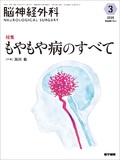Japanese
English
- 有料閲覧
- Abstract 文献概要
- 1ページ目 Look Inside
- 参考文献 Reference
Point
・個々人に合わせた適正血圧・正常な炭酸ガス分圧の維持,脱水を避ける十分な体液管理が基本となる.
・術後早期にはSPECTやPETによる脳血流評価を適切に組み合わせて,過灌流を早期に診断する.
・血圧管理,抗血小板療法,脳保護薬の併用など,多面的な戦略によって周術期合併症の最小化を図る.
Moyamoya disease is a chronic cerebrovascular disorder characterized by progressive stenosis or occlusion of the terminal portion of the internal carotid artery around the circle of Willis, thereby forming fragile collateral vessels(moyamoya vessels). Although ischemic symptoms predominate in pediatric cases, adult cases often involve ischemic and hemorrhagic events. Surgical revascularization effectively improves long-term outcomes; however, perioperative complications, such as ischemic events, hyperperfusion syndrome, and hemorrhagic complications, remain challenging.
Perioperative management aims to minimize the risk of ischemia and hemorrhage by stabilizing blood pressure, maintaining fluid and electrolyte balance, and implementing optimal ventilation strategies. Intraoperative management aims to prevent ischemic events by ensuring careful hemodynamic and respiratory monitoring and maintaining adequate cerebral perfusion during bypass procedures. Postoperative care emphasizes the early detection and management of hyperperfusion syndrome using imaging modalities, such as PET and SPECT, together with tailored blood pressure control and pharmacological interventions.
Meta-analyses and systematic reviews have underscored the importance of selecting the appropriate surgical technique(direct, indirect, or combined bypass) to minimize complications. Although combined bypass techniques may offer long-term outcomes, particularly in pediatric patients, individualized management strategies are essential to address the complex perioperative risks associated with moyamoya disease. Further research is needed to refine surgical approaches and optimize patient outcomes.

Copyright © 2025, Igaku-Shoin Ltd. All rights reserved.


